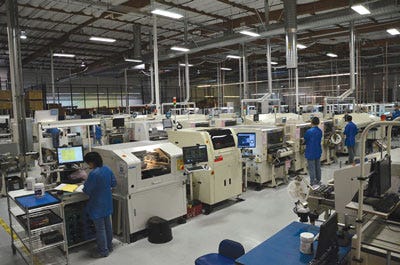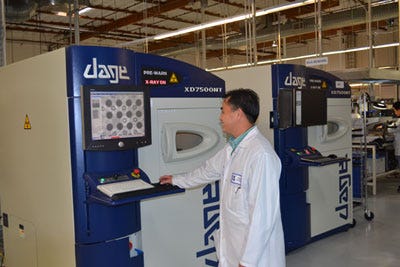6 Things to Remember When Working with an EMS Provider
November 13, 2014
There can be plenty to juggle when partnering with an electronic manufacturing services (EMS) provider. Here's how to avoid dropping one of the balls.
By Chris Alessio, VP Sales and Programs, Hunter Technology Corp.
|
Medtech OEMs should consider working with an EMS listed as an IPC Trusted Manufacturing Source. Shown here is Hunter's facility in Milpitas, CA. |
The path to a finished medical device is studded with stringent requirements, substantial investments, and federal and state limitations. When an OEM decides to use an electronic manufacturing services (EMS) provider, the process becomes even more complicated and requires even more research and planning.
The extra effort, though, can be worth it: outsourcing to the right EMS provider can be more cost-effective than developing and sustaining internal manufacturing operations. The EMS can provide a competitive edge because the OEM's core competency remains uncompromised. Plus, many EMS providers bring a wealth of design experience and manufacturing know-how to the table.
According to Frost & Sullivan, the medical EMS market is expected to reach $34.38 billion in 2019. One of the reasons this market has flourished is that EMS providers strive to be a seamless extension of the OEM's operation. For that to happen, effective vendor selection is one of the most important processes an OEM will go through.
Here are six quick tips to put OEMs on the path to a successful partnership with an EMS provider:
1. Prevent Hidden Costs: Define and Share a Clear Outsourcing Strategy
Before an OEM evaluates an EMS provider, it must first define its outsourcing strategy. Will the process begin with design for manufacturing? Will raw materials be provided to the EMS or will the EMS manage the ordering processes? How will part substitutions be handled? And who will handle test? Shipping? Product repairs?
Sharing specific expectations is one of the most proactive measures OEMs can take to get an accurate estimate of outsourcing costs. Likewise, other considerations include requalification process cost, excess and obsolete inventory reconciliation costs and non-recurring engineering expenses.
2. Stay Compliant: Develop a List of Required Certifications
To prevent unwarranted expenses while adhering to stringent regulations, the ISO 13485 and ISO 9001 certifications are especially important for medical EMS providers. State and federal regulations are critical as well. For example, Hunter Technology Corp. (Milpitas, CA) is licensed by the California Department of Public Health Food and Drug Branch (FDB) to manufacture finished medical devices for its OEMs. This ensures compliance with the stringent quality standards of California's device manufacturing license laws.
OEMs should also look for EMS providers that are certified beyond the minimum requirements.
3. Maintain the Pipeline: Require Automated ERP and Component Review Tools
The medical materials pipeline should be managed using a sophisticated enterprise resource planning (ERP) system--a resource in which the best EMS providers invest heavily. Because the cost and liability associated with materials is high, traceability, documentation, and process integrity are essential. For example, ERP systems ensure the traceability of every component by documenting its origin, lot number, and work order.
Another advantage an EMS can offer medical device and equipment manufacturers is the guaranteed availability of components. Engineers tend to design products that include components with which they're familiar. Should any of the components become obsolete over the life of the product, the manufacturer is faced with a pile of paperwork to substitute new components--assuming the parts can be found in time to meet production deadlines. To help manufacturers avoid this nightmare, the EMS provider should run every bill of materials through an IHS BOM review tool to indicate which parts will continue to be available from multiple sources, the number of years the part is expected to be available and the long-term prediction of obsolescence. Components that may not be readily available in the near future are flagged using an external, open-source database.
4. Consider the Three Pillars of Success: Profile, Price, Personality
Business Profile and Technical Capabilities Must Align: OEMs can narrow down their search for an EMS provider by considering only those with a business profile similar to their own. The medical industry gravitates toward a high-mix, low-volume business profile because it requires more sophisticated infrastructure to support regulatory and quality requirements. If an EMS provider is not focused on complex products used in high-stakes industries such medical, defense, and aerospace, the OEM will need to determine whether the EMS provider has the financial resources to invest in the technology and quality certifications needed--especially as project complexity grows.
|
Figure 1: Dage sealed x-ray tube inspection systems enable technicians to inspect PCBs from any angle. |
An EMS provider's technical capabilities are an important factor of its business profile because one of the most challenging aspects of manufacturing is the constant investment in capital equipment. Advanced test equipment in particular can make the difference between meeting deadlines with quality products--or not. For instance, Hunter recently added two Dage sealed x-ray-tube inspection systems (Figure 1) featuring approximately 0.95 microns of feature recognition, a 740× geometric magnification, and a 70° oblique viewing angle. Between rotating the base and rotating the tube, technicians can inspect any hidden joint or point on a printed circuit board from any angle.
Capital equipment is just part of the story. OEMs should ask prospective EMS providers to walk through all of the processes involved, including administrative capabilities, documentation, materials requirement plans, engineering change orders, product risk analysis, and adaptation. Ask questions like: Will forecast variability windows be established to prepare for product demand? Are risk buys on scarce components needed? How will overall success be measured? Chances are, if an OEM isn't comfortable with how a prospective EMS team manages a multilevel supply chain (or does business in general), the partnership won't work.
Price of the Total Acquisition is What Matters: Issuing a request for outsourced contract manufacturing services will inevitably result in dozens of proposals. However, only a fraction of those proposals will come from qualified EMS providers and include accurate estimates. By default, almost all prospective EMS will commit to adhere to the production schedule, but not all will take into account variables that may drive up the cost. Factors to consider include geographic proximity, production overtime, repair, component price fluctuations, and other "what-ifs." To make it easier to evaluate intangibles such as flexibility and ease of the partnership, give each a numerical value.
When faced with a mountain of proposals, the large amount of time that will be spent filtering through a broad set of quotes and preliminary questions must also be included in the total cost of acquisition. That's why selecting from a more narrow pool of EMS providers and then calculating the entire cost model results in a more accurate estimate. The financial forecast of a partnership must benefit both parties, so every detail of the proposal must be reviewed and updated over time.
Personality Matchmaking Helps Enable an Optimal Partnership: The EMS provider will ultimately serve as the OEM's advocate with suppliers, and even as an ambassador to customers. Consequently, OEMs must consider the chemistry between the two company cultures, as well as personality matches among the core team. This is especially true when it comes to the program manager and front-line team in charge of engineering, quality, ECOs, etc.One way to gauge the potential for partnership is to walk the EMS provider's manufacturing floor looking for evidence of how they support other OEM customers. Encourage the EMS's representatives and management to discuss projects they've worked on for similar OEMs--especially what went right and what could have been improved. When it comes to high-mix, low-volume contract manufacturing services, in-person meetings are the best way to determine a personality match, offer feedback, and develop mutual trust.
5. Cultivate Flexibility: Anticipate As Many Future Requirements as Possible
A successful selection process involves assessing an EMS provider's processes and capabilities from two vantage points: current and long-term/anticipated requirements. Any gaps in the EMS provider's proposal--like the absence of a medical project launch strategy or lack of investment in equipment--are red flags. To avoid wasting time, OEMs must be clear about their expectations from the beginning. Ironically, this sort of rigidity in the initial selection process begets flexibility in the overall partnership. Reliable EMS providers are willing to work around the clock to meet their OEM customers' fluctuating deadlines because the OEM's success is their success. This includes the willingness to make weekend deliveries to customers, change production levels without a lot of fuss, reallocate resources before it becomes critical, and more.
6. Prevent the Unexpected: Involve the EMS Provider in NPI
Manufacturing efficiency improves when the EMS provider is given the opportunity to be involved from the ground up. For example, design engineers from both companies can work together to develop a product that is designed for more efficient manufacturing, effective testing and a more rapid new product introduction (NPI) process. Even when engineering changes level off and production ramps up, it is essential for that the OEM and EMS teams stay in contact, as the best EMS providers will continue to make viable suggestions--for example, the substitution of equivalent parts that can increase efficiency, reduce cost, reduce lead time and minimize liability once the product is in production. For example, Hunter does this using a Valor for DFM tool to automate research and enhances the NPI process. Engineering, design, and product development teams are provided with real-time information as new components are released. For manufacturers who don't have time to research this information, partnering with an EMS with automated DFM tool capabilities is a distinct advantage. In the NPI phase and beyond, automated tools like this will reveal the overall manufacturability of the product, which eliminates process/material variations, addresses learning curves and improves throughput and yields.
Conclusion: Forging the Path to a Cost Effective, Competitive Partnership
The OEM-EMS partnership can be one of the most fruitful business relationships in the medical device market, as both parties must walk within the parameters of increasing regulations and the continued pressure to reduce cost. Both must make weighty decisions that have long term effects. By preventing hidden costs, remaining compliant, maintaining the manufacturing pipeline, cultivating flexibility, and staying diligent in all other areas during the selection process, the right EMS provider will be one of the most integral parts of an OEM's process.
About the Author(s)
You May Also Like



.png?width=300&auto=webp&quality=80&disable=upscale)
